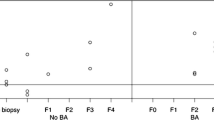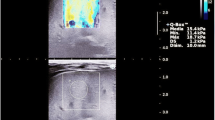Abstract
Background
Children with biliary atresia are prone to developing progressive hepatic fibrosis and biliary cirrhosis following the Kasai operation. The only treatment is liver transplantation.
Objective
To assess liver fibrosis by acoustic radiation force impulse elastography (ARFI) in children who had Kasai operation, with the goal of identifying an ARFI value cut-off for children requiring liver transplantation.
Materials and methods
Of the 32 post-Kasai children included, 19 were transplanted or listed for transplantation (group A), while 13 were not on the list during their follow-up (group B). We recorded biopsies, blood samples and ARFI values over time, including at Kasai operation and at transplantation. We estimated an association between groups and continuous variables using generalized estimating equations, and we compared categorical variables using the Fisher exact test.
Results
Portal hypertension signs were similar in both groups, whereas ARFI values were higher in group A (mean±standard deviation=3.3±1.2 m/s) than in group B (2.0±0.7 m/s; P=.0003). Eighteen of 19 (94.7%) children in group A and 6/13 (46.2%) children in group B presented with two consecutive ARFI values ≥2 m/s (sensitivity=7%, specificity=53.8%; P=0.003).
Conclusion
We found that children who were transplanted had two consecutive ARFI values ≥2 m/s during follow-up. ARFI for evaluation of post-Kasai liver fibrosis may assist the long-term assessment of biliary atresia and may even guide treatment decisions.


Similar content being viewed by others
References
Chardot C, Buet C, Serinet MO et al (2013) Improving outcomes of biliary atresia: French national series 1986–2009. J Hepatol 58:1209–1217
Serinet MO, Wildhaber BE, Broue P et al (2009) Impact of age at Kasai operation on its results in late childhood and adolescence: a rational basis for biliary atresia screening. Pediatrics 123:1280–1286
Chung PH, Wong KK, Tam PK (2015) Predictors for failure after Kasai operation. J Pediatr Surg 50:293–296
Fouquet V, Alves A, Branchereau S et al (2005) Long-term outcome of pediatric liver transplantation for biliary atresia: a 10-year follow-up in a single center. Liver Transpl 11:152–160
Hanquinet S, Rougemont AL, Courvoisier D et al (2013) Acoustic radiation force impulse (ARFI) elastography for the noninvasive diagnosis of liver fibrosis in children. Pediatr Radiol 43:545–551
Noruegas MJ, Matos H, Goncalves I et al (2012) Acoustic radiation force impulse-imaging in the assessment of liver fibrosis in children. Pediatr Radiol 42:201–204
Shima H, Igarashi G, Wakisaka M et al (2012) Noninvasive acoustic radiation force impulse (ARFI) elastography for assessing the severity of fibrosis in the post-operative patients with biliary atresia. Pediatr Surg Int 28:869–872
Uchida H, Sakamoto S, Kobayashi M et al (2015) The degree of spleen stiffness measured on acoustic radiation force impulse elastography predicts the severity of portal hypertension in patients with biliary atresia after portoenterostomy. J Pediatr Surg 50:559–564
Gana JC, Turner D, Roberts EA et al (2010) Derivation of a clinical prediction rule for the noninvasive diagnosis of varices in children. J Pediatr Gastroenterol Nutr 50:188–193
Megremis SD, Vlachonikolis IG, Tsilimigaki AM (2004) Spleen length in childhood with US: normal values based on age, sex, and somatometric parameters. Radiology 231:129–134
Hanquinet S, Courvoisier D, Kanavaki A et al (2013) Acoustic radiation force impulse imaging-normal values of liver stiffness in healthy children. Pediatr Radiol 43:539–544
Diaz JJ, Gura KM, Roda J et al (2013) Aspartate aminotransferase to platelet ratio index correlates with hepatic cirrhosis but not with fibrosis in pediatric patients with intestinal failure. J Pediatr Gastroenterol Nutr 57:367–371
Kim SY, Seok JY, Han SJ et al (2010) Assessment of liver fibrosis and cirrhosis by aspartate aminotransferase-to-platelet ratio index in children with biliary atresia. J Pediatr Gastroenterol Nutr 51:198–202
Chevallier M, Guerret S, Chossegros P et al (1994) A histological semiquantitative scoring system for evaluation of hepatic fibrosis in needle liver biopsy specimens: comparison with morphometric studies. Hepatology 20:349–355
Barr RG, Ferraioli G, Palmeri ML et al (2015) Elastography assessment of liver fibrosis: society of radiologists in ultrasound consensus conference statement. Radiology 276:845–861
Honsawek S, Chayanupatkul M, Chongsrisawat V et al (2011) Serum adiponectin and transient elastography as non-invasive markers for postoperative biliary atresia. BMC Gastroenterol 11:16
Honsawek S, Chongsrisawat V, Praianantathavorn K et al (2011) Elevation of serum galectin-3 and liver stiffness measured by transient elastography in biliary atresia. Eur J Pediatr Surg 21:250–254
Honsawek S, Vejchapipat P, Payungporn S et al (2013) Soluble receptor for advanced glycation end products and liver stiffness in postoperative biliary atresia. Clin Biochem 46:214–218
Chongsrisawat V, Vejapipat P, Siripon N et al (2011) Transient elastography for predicting esophageal/gastric varices in children with biliary atresia. BMC Gastroenterol 11:41
Friedrich-Rust M, Wunder K, Kriener S et al (2009) Liver fibrosis in viral hepatitis: noninvasive assessment with acoustic radiation force impulse imaging versus transient elastography. Radiology 252:595–604
Bota S, Sporea I, Sirli R et al (2015) How useful are ARFI elastography cut-off values proposed by meta-analysis for predicting the significant fibrosis and compensated liver cirrhosis? Med Ultrason 17:200–205
Acknowledgments
We tank Isabelle Bosquet, pediatric radiology nurse at Children’s Hospital Geneva, Switzerland, for data management.
Author information
Authors and Affiliations
Corresponding author
Ethics declarations
Conflicts of interest
None
Rights and permissions
About this article
Cite this article
Hanquinet, S., Courvoisier, D.S., Rougemont, AL. et al. Acoustic radiation force impulse sonography in assessing children with biliary atresia for liver transplantation. Pediatr Radiol 46, 1011–1016 (2016). https://doi.org/10.1007/s00247-016-3565-3
Received:
Revised:
Accepted:
Published:
Issue Date:
DOI: https://doi.org/10.1007/s00247-016-3565-3




